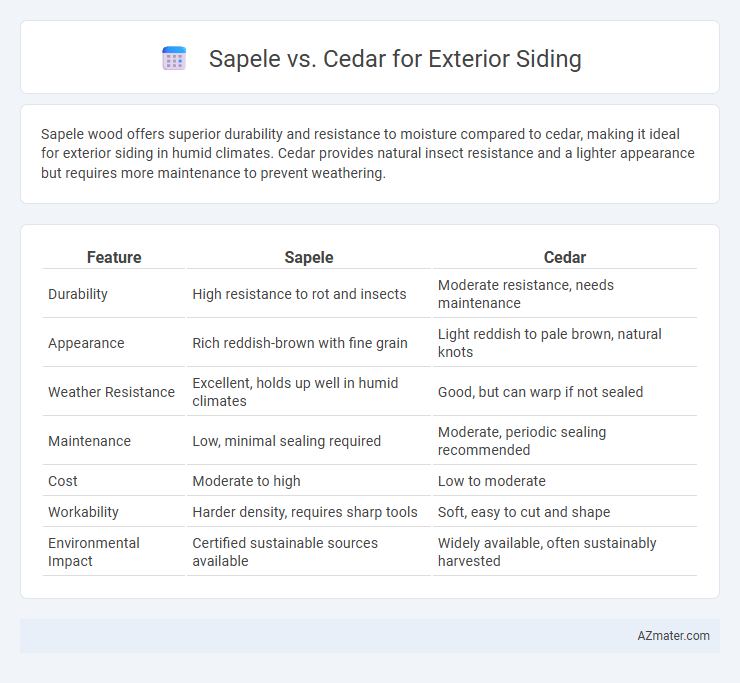Sapele wood offers superior durability and resistance to moisture compared to cedar, making it ideal for exterior siding in humid climates. Cedar provides natural insect resistance and a lighter appearance but requires more maintenance to prevent weathering.
Table of Comparison
| Feature | Sapele | Cedar |
|---|---|---|
| Durability | High resistance to rot and insects | Moderate resistance, needs maintenance |
| Appearance | Rich reddish-brown with fine grain | Light reddish to pale brown, natural knots |
| Weather Resistance | Excellent, holds up well in humid climates | Good, but can warp if not sealed |
| Maintenance | Low, minimal sealing required | Moderate, periodic sealing recommended |
| Cost | Moderate to high | Low to moderate |
| Workability | Harder density, requires sharp tools | Soft, easy to cut and shape |
| Environmental Impact | Certified sustainable sources available | Widely available, often sustainably harvested |
Introduction: Sapele vs Cedar for Exterior Siding
Sapele and cedar are popular choices for exterior siding due to their durability and aesthetic appeal. Sapele, a tropical hardwood from West Africa, offers rich reddish-brown tones and exceptional resistance to rot and insect damage. Cedar, known for its natural oils and aromatic scent, provides excellent weather resistance and a lighter, warm appearance that weathers to a charming silver-gray over time.
Overview of Sapele Wood
Sapele wood is a tropical hardwood native to West Africa, prized for its rich reddish-brown color and fine grain, making it an attractive choice for exterior siding. Its natural durability and resistance to rot and insect damage contribute to its suitability in exterior applications, outperforming many softwoods in longevity. Sapele's dimensional stability ensures it resists warping and splitting, providing a reliable and aesthetically pleasing siding material for exterior cladding.
Overview of Cedar Wood
Cedar wood, commonly used for exterior siding, boasts natural resistance to decay, insects, and moisture, making it highly durable in varying climates. Its lightweight yet strong properties enable ease of installation while providing excellent insulation benefits. The wood's rich aromatic scent and attractive grain patterns enhance aesthetic appeal, contributing to its popularity in siding applications.
Durability and Weather Resistance
Sapele wood offers exceptional durability and weather resistance for exterior siding due to its dense grain structure and natural oils that resist moisture, rot, and insect damage. Cedar also provides strong weather resistance and decay protection, largely because of its natural preservatives, but it is softer and slightly less dense than Sapele, making it more prone to dents and scratches. Both woods perform well outdoors, but Sapele's higher density and hardness give it an edge in long-term durability under harsh weather conditions.
Aesthetic Differences: Appearance & Grain
Sapele wood showcases a rich, reddish-brown hue with a strikingly interlocked grain pattern that creates a ribbon-like effect, enhancing its visual depth and warmth for exterior siding. In contrast, Cedar features a lighter, more uniform color palette ranging from pale amber to reddish tones, with a straight, fine grain that offers a smooth and consistent appearance. The aesthetic distinction between Sapele's bold, textured grain and Cedar's subtle, even finish makes each wood uniquely suited for varied architectural styles and design preferences.
Maintenance Requirements
Sapele wood requires moderate maintenance for exterior siding, including regular sealing or oiling to preserve its natural resistance to rot and insect damage. Cedar offers lower maintenance demands due to its inherent oils that resist moisture, decay, and insect infestation, making it more durable with fewer treatments. Both woods benefit from cleaning and periodic inspections, but cedar's natural properties reduce the frequency of upkeep compared to sapele.
Cost Comparison: Sapele vs Cedar
Sapele offers a cost-effective alternative to cedar for exterior siding, typically priced 20-30% lower due to its abundance and faster growth cycle. Cedar is generally more expensive because of its natural resistance to decay and insect damage, which reduces maintenance costs over time. When comparing total investment, Sapele provides initial savings, while cedar may offer longer-term durability benefits that can affect overall lifetime costs.
Sustainability and Environmental Impact
Sapele wood offers superior durability and natural resistance to decay and insects, reducing the need for chemical treatments, which enhances its environmental sustainability for exterior siding. Cedar, known for its renewable growth rate and low carbon footprint, provides excellent insulation properties and biodegradability, making it an eco-friendly choice with minimal environmental impact. Both woods are sustainable when sourced from responsibly managed forests, but cedar's faster growth cycle often results in a more favorable carbon sequestration balance.
Workability and Installation Considerations
Sapele wood offers high workability with its fine, even texture and robust density, making it suitable for precise cuts and detailed installation in exterior siding. Cedar, known for its lighter weight and straight grain, allows easier handling and faster installation but may require more careful fastening to prevent splitting. Selecting between Sapele and Cedar involves balancing Sapele's durability and machining ease against Cedar's effortless installation and flexibility on exterior surfaces.
Which is Better for Exterior Siding? Final Verdict
Sapele offers superior durability and natural resistance to decay and insects, making it an excellent choice for exterior siding in various climates. Cedar provides a lighter, more aromatic wood that is naturally resistant to moisture and pests but may require more frequent maintenance to retain its appearance and protection. For long-lasting exterior siding with minimal upkeep, Sapele is generally the better option due to its dense grain and enhanced weather resistance.

Infographic: Sapele vs Cedar for Exterior Siding
 azmater.com
azmater.com